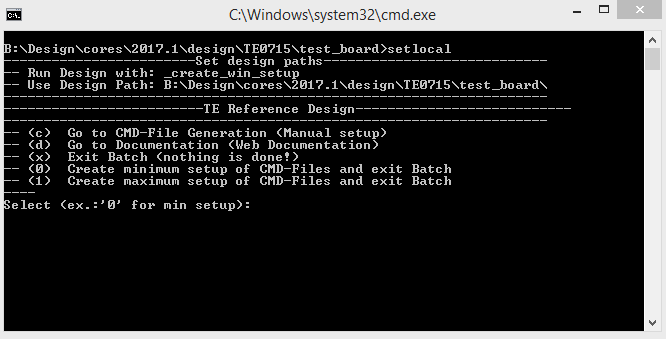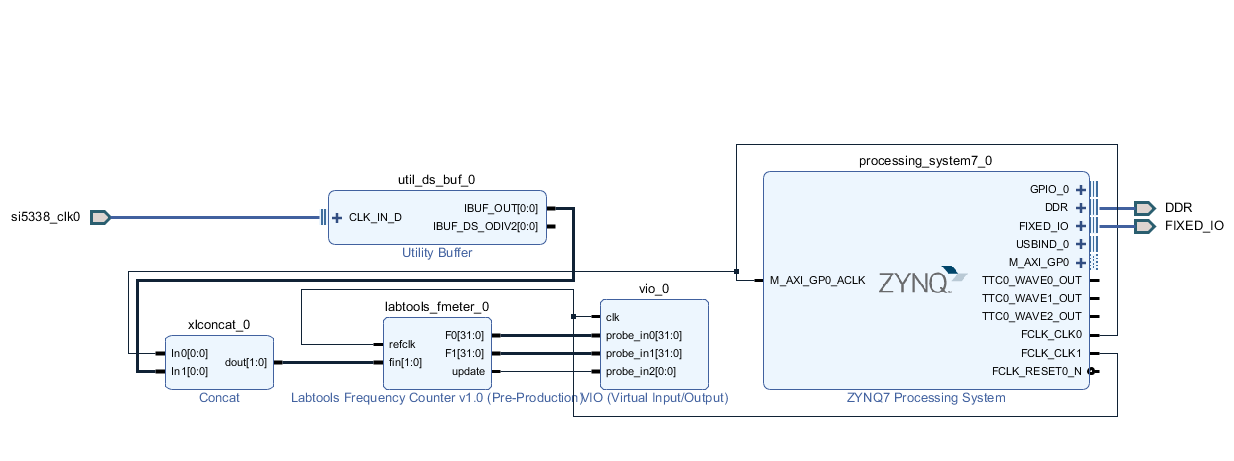Page History
...
| Excerpt |
|---|
|
Revision History
| HTML |
|---|
<!-- - Add changes from design - Export PDF to download, if vivado revision is changed! --> |
...
| Module Model | Board Part Short Name | PCB Revision Support | Notes | |||
|---|---|---|---|---|---|---|
| TE0745-02-30-1I | 30 | 01,02 | ||||
| TE0745-02-35-1C | 01,02 | |||||
| 2 |
Design supports following carriers:
| Carrier Model | Notes |
|---|---|
| ---TEB0745 |
Additional HW Requirements:
...
- _create_win_setup.cmd/_create_linux_setup.sh and follow instructions on shell:
- Press 0 and enter for minimum setup
- (optional Win OS) Generate Virtual Drive or use short directory for the reference design (for example x:\<design name>)
- Create Project
- Select correct device and Xilinx install path on "design_basic_settings.cmd" and create Vivado project with "vivado_create_project_guimode.cmd"
Note: Select correct one, see TE Board Part Files
- Select correct device and Xilinx install path on "design_basic_settings.cmd" and create Vivado project with "vivado_create_project_guimode.cmd"
- Create HDF and export to prebuilt folder
- Run on Vivado TCL: TE::hw_build_design -export_prebuilt
Note: Script generate design and export files into \prebuilt\hardware\<short dir>. Use GUI is the same, except file export to prebuilt folder
- Run on Vivado TCL: TE::hw_build_design -export_prebuilt
- Create Linux (uboot.elf and image.ub) with exported HDF
- HDF is exported to "prebuilt\hardware\<short name>"
Note: HW Export from Vivado GUI create another path as default workspace. - Create Linux images on VM, see PetaLinux KICKstart
- Use TE Template from /os/petalinux
Note: run init_config.sh before you start petalinux config. This will set correct temporary path variable.
- Use TE Template from /os/petalinux
- HDF is exported to "prebuilt\hardware\<short name>"
- Add Linux files (uboot.elf and image.ub) to prebuilt folder
- "prebuilt\os\petalinux\default" or "prebuilt\os\petalinux\<short name>"
Notes: Scripts select "prebuilt\os\petalinux\<short name>", if exist, otherwise "prebuilt\os\petalinux\default"
- "prebuilt\os\petalinux\default" or "prebuilt\os\petalinux\<short name>"
- Generate Programming Files with HSI/SDK
- Run on Vivado TCL: TE::sw_run_hsi
Note: Scripts generate applications and bootable files, which are defined in "sw_lib\apps_list.csv" - (alternative) Start SDK with Vivado GUI or start with TE Scripts on Vivado TCL: TE::sw_run_sdk
Note: See SDK Projects
- Run on Vivado TCL: TE::sw_run_hsi
...
- Generate Platform Project or use prebuilt from download
- ...
Launch
Programming
| HTML |
|---|
<!-- Description of Block Design, Constrains... BD Pictures from Export... --> |
...
- Prepare HW like described on section Programming
- Connect UART USB (most cases same as JTAG)
- Select SD Card as Boot Mode
Note: See TRM of the Carrier , which is usedand Module. - Power On PCB
Note: 1. Zynq Boot ROM loads FSBL from SD into OCM, 2. FSBL loads U-boot from SD into DDR, 3. U-boot load Linux from SD into DDR
...
- Open Serial Console (e.g. putty)
- Speed: 115200
- COM Port: Win OS, see device manager, Linux OS see dmesg |grep tty (UART is *USB1)
- Linux Console:
Note: Wait until Linux boot finished For Linux Login use:- User Name: root
- Password: root
System Design - Vivado
| HTML |
|---|
<!--
Description of Block Design, Constrains...
BD Pictures from Export...
--> |
Block Design
PS Interfaces
Constrains
Basic module constrains
...
| language | ruby |
|---|---|
| title | _i_bitgen_common.xdc |
- You can use Linux shell now.
- I2C 0 Bus type: i2cdetect -y -r 0
- RTC check: dmesg | grep rtc
- ETH0 works with udhcpc
- USB type "lsusb" or connect USB2.0 device
Vivado HW Manager
SI5338_CLK0 Counter:
- Open Vivado HW-Manager and add VIO signal to dashboard (*.ltx located on prebuilt folder).
- Set radix from VIO signals to unsigned integer.
Note: Frequency Counter is inaccurate and displayed unit is Hz
- Set radix from VIO signals to unsigned integer.
SI5338 CLK is configured to 125MHz by default.
System Design - Vivado
Design specific constrain
...
| language | ruby |
|---|---|
| title | _i_io.xdc |
...
| HTML |
|---|
<!-- optional chapter separate sections for different appsDescription of Block Design, Constrains... BD Pictures from Export... --> |
For SDK project creation, follow instructions from:
Application
FSBL
Xilinx default FSBL
U-Boot
U-Boot.elf is generated with PetaLinux. SDK/HSI is used to generate Boot.bin.
Software Design - PetaLinux
| HTML |
|---|
<!--
optional chapter
Add "No changes." or "Activate: -->List"
--> |
For PetaLinux installation and project creation, follow instructions from:
Config
No changes.
U-Boot
No changes.
Device Tree
| Code Block | ||
|---|---|---|
| ||
/include/ "system-conf.dtsi"
/ {
};
|
Kernel
No changes.
Rootfs
...
Block Design
PS Interfaces
| Type | Note |
|---|---|
| DDR | |
| QSPI | MIO |
| ETH0 | MIO |
| USB0 | MIO |
| SD0 | MIO |
| UART0 | MIO |
| I2C0 | MIO |
| GPIO | MIO/EMIO |
| ETH0 Reset | MIO |
| USB0 Reset | MIO |
| I2C0 Reset | MIO |
| Timer 0 | EMIO |
Constrains
Basic module constrains
| Code Block | ||||
|---|---|---|---|---|
| ||||
set_property BITSTREAM.GENERAL.COMPRESS TRUE [current_design]
set_property CONFIG_VOLTAGE 1.8 [current_design]
set_property CFGBVS GND [current_design] |
Design specific constrain
No additional constrains.
Software Design - SDK/HSI
| HTML |
|---|
<!--
optional chapter
separate sections for different apps
--> |
For SDK project creation, follow instructions from:
Application
FSBL
TE modified 2017.2 FSBL
Changes:
- Si5338 Configuration see fsbl_hooks.c
- Add register_map.h, si5338.c, si5338.h
U-Boot
U-Boot.elf is generated with PetaLinux. SDK/HSI is used to generate Boot.bin.
Software Design - PetaLinux
| HTML |
|---|
<!--
optional chapter
Add "No changes." or "Activate: -->List"
--> |
For PetaLinux installation and project creation, follow instructions from:
Config
No changes.
U-Boot
No changes.
Device Tree
| Code Block | ||
|---|---|---|
| ||
/include/ "system-conf.dtsi"
/ {
};
/* ethernet */
&gem0 {
phy-handle = <&phy0>;
mdio {
#address-cells = <1>;
#size-cells = <0>;
phy0: phy@1 {
compatible = "marvell,88e1510";
device_type = "ethernet-phy";
reg = <1>;
} ;
} ;
};
/* usb */
/{
usb_phy0: usb_phy@0 {
compatible = "ulpi-phy";
#phy-cells = <0>;
reg = <0xe0002000 0x1000>;
view-port = <0x0170>;
drv-vbus;
};
};
&usb0 {
dr_mode = "host";
//dr_mode = "peripheral";
usb-phy = <&usb_phy0>;
};
/* flash */
&flash0 {
compatible = "micron,n25q256a";
#size-cells = <1>;
reg = <0x0>;
spi-tx-bus-width = <1>;
spi-rx-bus-width = <4>;
spi-max-frequency = <10000000>;
};
/* I2C */
&i2c0 {
#address-cells = <1>;
#size-cells = <0>;
rtc0: rtc@6F {
compatible = "isl12022";
reg = <0x6F>;
};
i2cmux_SFP: i2cmux@72 {
compatible = "nxp,pca9548";
#address-cells = <1>;
#size-cells = <0>;
reg = <0x72>;
SFP@0 {
#address-cells = <1>;
#size-cells = <0>;
reg = <0>;
};
SFP@1 {
#address-cells = <1>;
#size-cells = <0>;
reg = <1>;
};
SFP@2 {
#address-cells = <1>;
#size-cells = <0>;
reg = <2>;
};
SFP@3 {
#address-cells = <1>;
#size-cells = <0>;
reg = <3>;
};
SFP@4 {
#address-cells = <1>;
#size-cells = <0>;
reg = <4>;
};
SFP@5 {
#address-cells = <1>;
#size-cells = <0>;
reg = <5>;
};
SFP@6 {
#address-cells = <1>;
#size-cells = <0>;
reg = <6>;
};
SFP@7 {
#address-cells = <1>;
#size-cells = <0>;
reg = <7>;
};
};
};
|
Kernel
Activate:
- USB_ULPI_BUS
- RTC_DRV_ISL12022
Rootfs
Activate:
- i2c-tools
Applications
startup
Script App to load init.sh from SD Card if available.
...
| HTML |
|---|
<!-- Add Description for other Software, for example SI CLK Builder ... --> |
...
SI5338
Download ClockBuilder Desktop for SI5338
- Install and start ClockBuilder
- Select SI5338
- Options → Open register map file
Note: File location <design name>/misc/Si5338/RegisterMap.txt - Modify settings
- Options → save C code header files
- Replace Header files from FSBL template with generated file
Appx. A: Change History and Legal Notices
...

